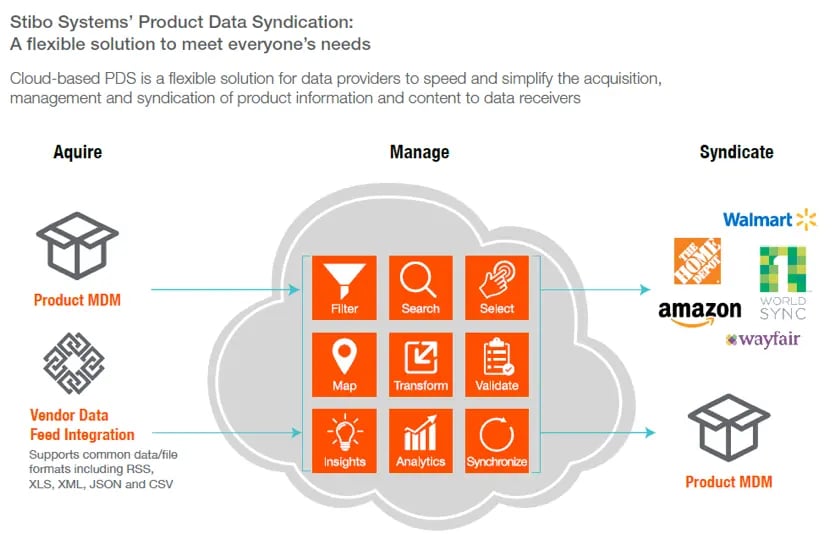One of the reasons for Amazon’s stunning success is their vast number of products – 564 million in the US alone according to the latest count. This makes Amazon more than an online shop; it’s a search engine for shopping.
As an MDM manager at a retailer, you probably want to imitate that success. This means, you have to launch new products quickly and reliably. This is only possible by means of PDX Syndication, a key component of the pdx system. The obstacle for a fast product launch is usually not logistics or even really about the physical product; it’s about the processing of that physical product’s master data twin.
So, what you truly want is to be able to consolidate the product’s master data and list it in your catalog or on your website.

Products are a commodity, which makes it difficult to build customer retention based on product quality alone. One of the means to retain customer loyalty is – as the Amazon case shows – to have the richest product offering, obviously in addition to providing great customer service and fast delivery.
If you want your customers to use your website as their one-stop shop you need to have a rich assortment available for sale, and of course always the newest products. Speed has become a crucial KPI. Customers expect to find the new mobile phone or the smart speaker on your website when they see the commercial from the manufacturer, not a week later.
Therefore, being the biggest and fastest retailer naturally attracts more customers.
To reach that goal, it’s critical to get rid of backlogs and manual processes for onboarding new products. A long and cumbersome onboarding process does not just cost time; it also ties up expensive manpower that could be re-allocated to more profitable work.
Slow product onboarding has many causes such as different formats and delivery methods of product data from manufacturers and suppliers that must be unified to fit the retailer’s catalog or commerce system.
Or – turning the table – the manufacturer must deal with an array of retailer requirements for different data formats. In some cases, the retailer can dictate the format; in other cases, the manufacturer dictates the data format.
Either way, the misfit of product data slows down the onboarding process.
SOLUTION SHEET
Reduce Workload and Speed Item Setup to Drive Growth
channels and partners. It’s everything you need in a single, dedicated cloud-based app.

Bridging the gap with PDX Syndication
PDX Syndication is the smart approach to a speedier product onboarding process that can boost the assortment growth and still maintain data consistency.
Retailers who can’t receive product data in their preferred format must translate it. PDX Syndication does exactly that. It connects disparate systems and translates supplier formats into retailer formats. The service bridges the gap between supplier and retailer and effectively shortens the product onboarding cycle.
Via PDX Syndication the suppliers can upload data in the format of their choice, say an Excel-file, and the receiver can get the same data according to their system requirements (e.g., as an xml file).
The data supplier only needs to map the product data against the retailer’s data model once in order to match the requirements. After the first data mapping, product onboarding becomes a seamless process. The service can then subscribe to the supplier’s content system and automatically perform a whole series of actions:
- Import data in the supplier’s format
- Select data to match the retailer’s requirements
- Map, transform and edit data, which is a particularly powerful means of translating units and local descriptions into the values of the receiver. Centimeters can be translated into inches, a size 50 to XL or the color turquoise to green, depending on the retailer’s preferred output.
- Validate data
- Generate data
- Submit the unified data set in the preferred format to the sales channel of choice, ecommerce system, MDM system or product catalog
The even smarter approach
A data syndication service must be format agnostic and designed to remove as many roadblocks as possible for the product onboarding process.
Therefore, some retailers choose to skip a step and provide an API for the PDX Syndication solution in order to enhance the automation.
This is the case for some of the very large retailers such as Home Depot, Walmart, and Amazon. They allow the syndication solution to feed product data directly into their ecommerce system.
The syndication solution is even capable of maintaining the retailer’s data model. If the product data doesn’t meet the requirements of the retailer’s data model, a validation process automatically notifies the supplier if there is incorrect or insufficient content and prompts the supplier to attempt a new upload.
Furthermore, the retailer can update his data model anytime; the supplier will be notified about the changes, which enables him to keep his product information up-to-date.

Direct integration via API to the PDX Syndication service is without doubt the way to work smarter and achieve speed without jeopardizing the data quality. The solution removes error-prone processes and ensures data consistency. It also makes it easier to be a supplier, strengthening the collaboration between manufacturers and retailers who can, respectively, go back to focusing on manufacturing new products and driving more traffic to their websites.
EXPLORE






































































































































































































